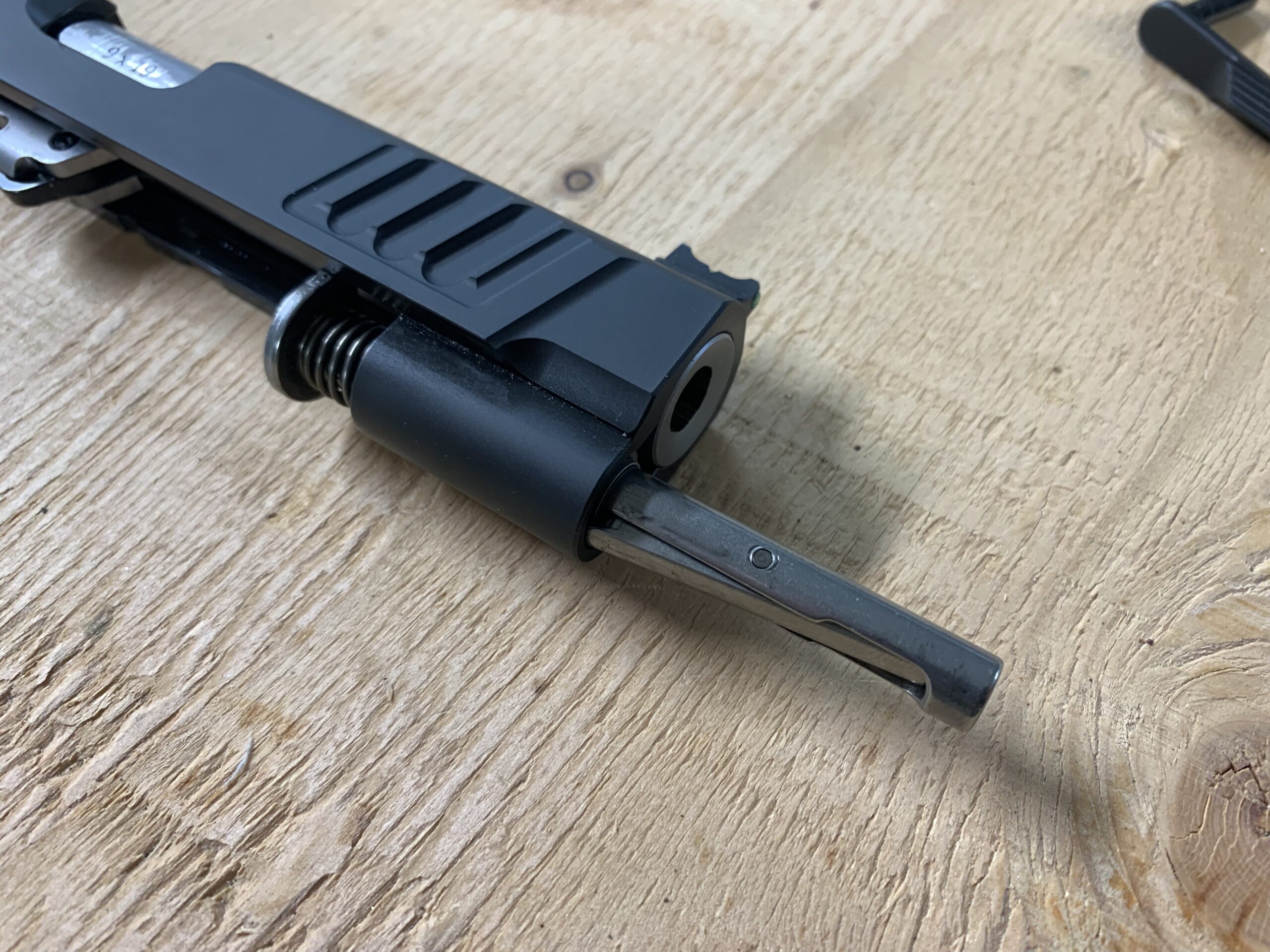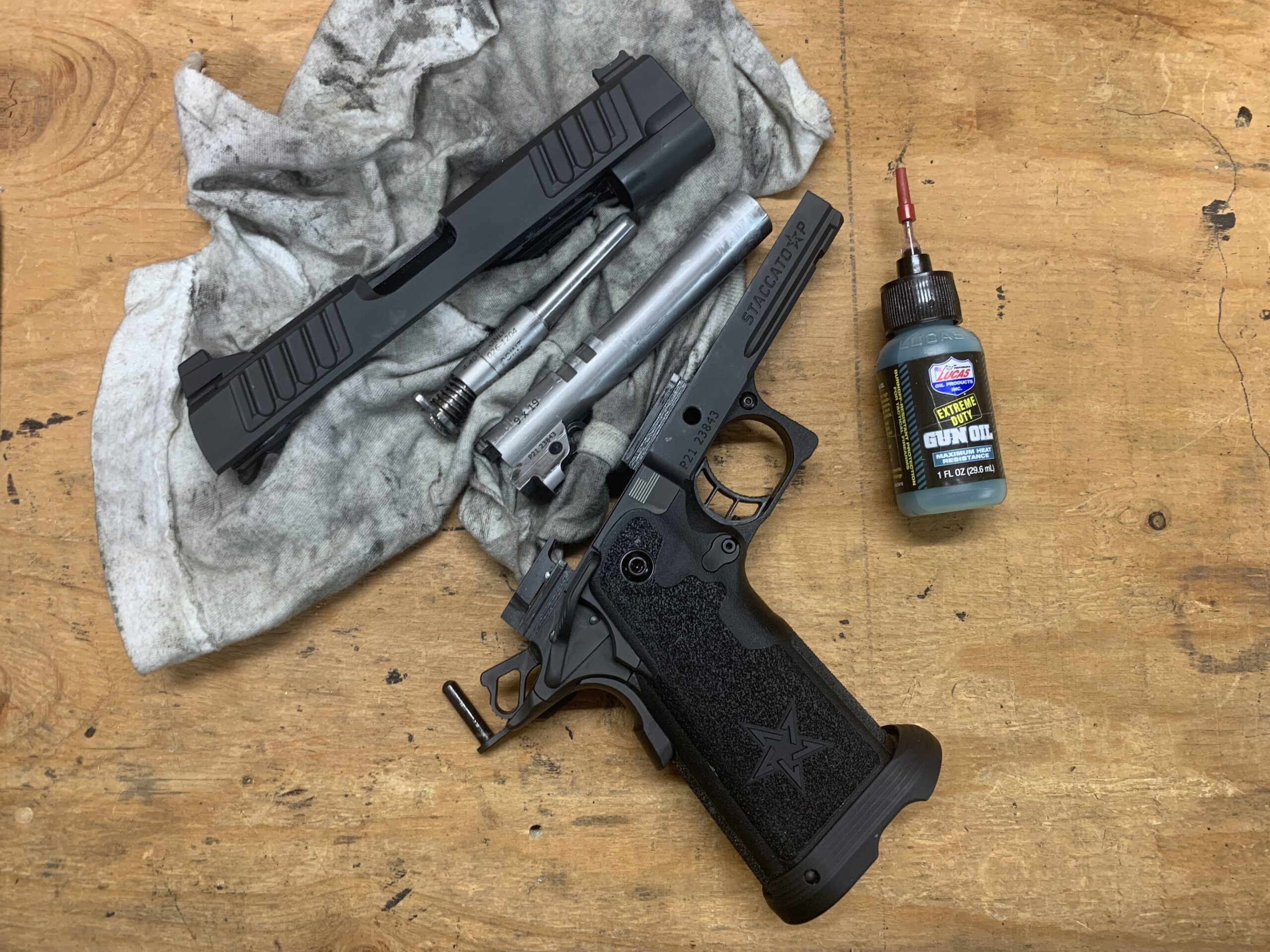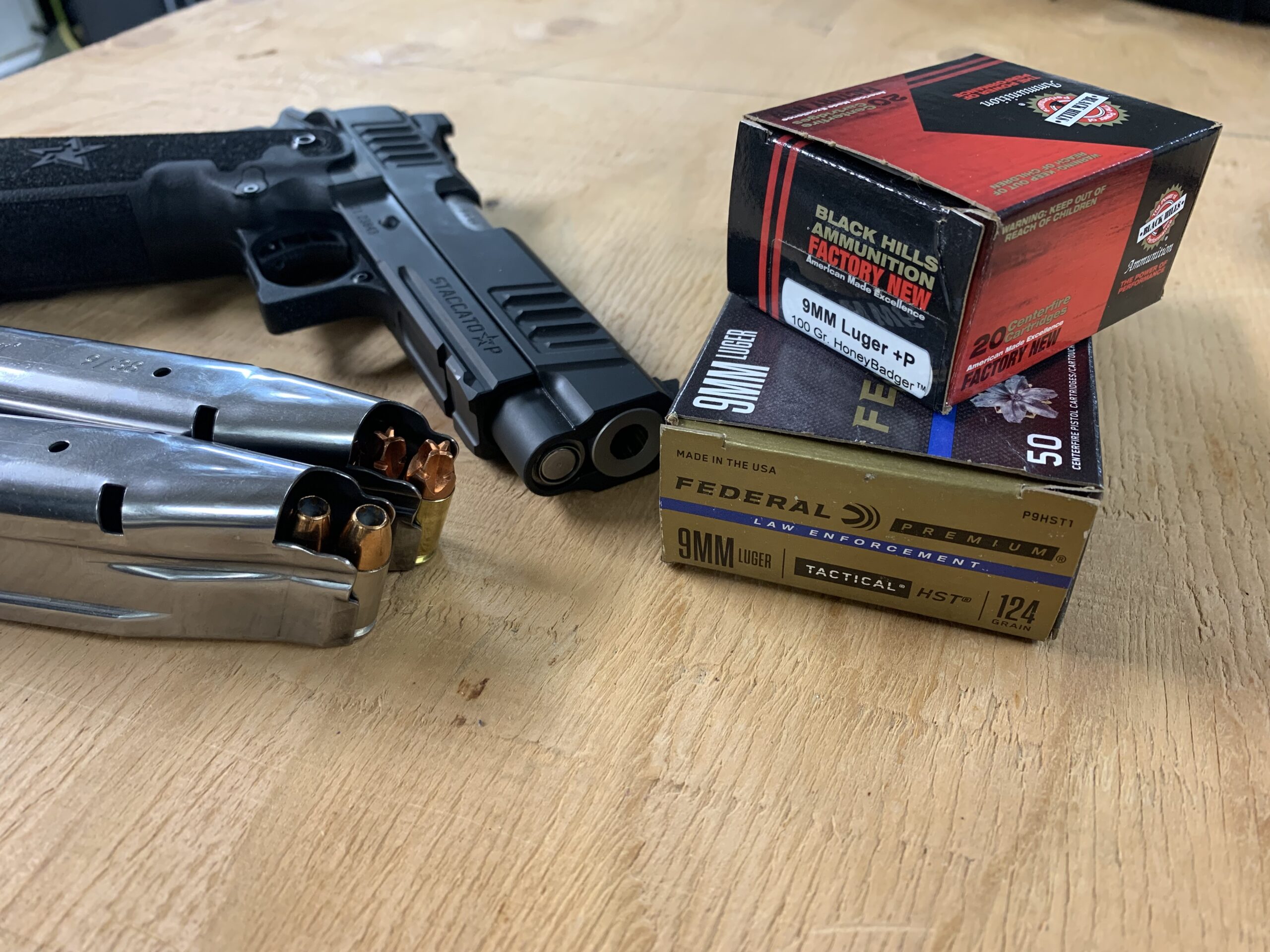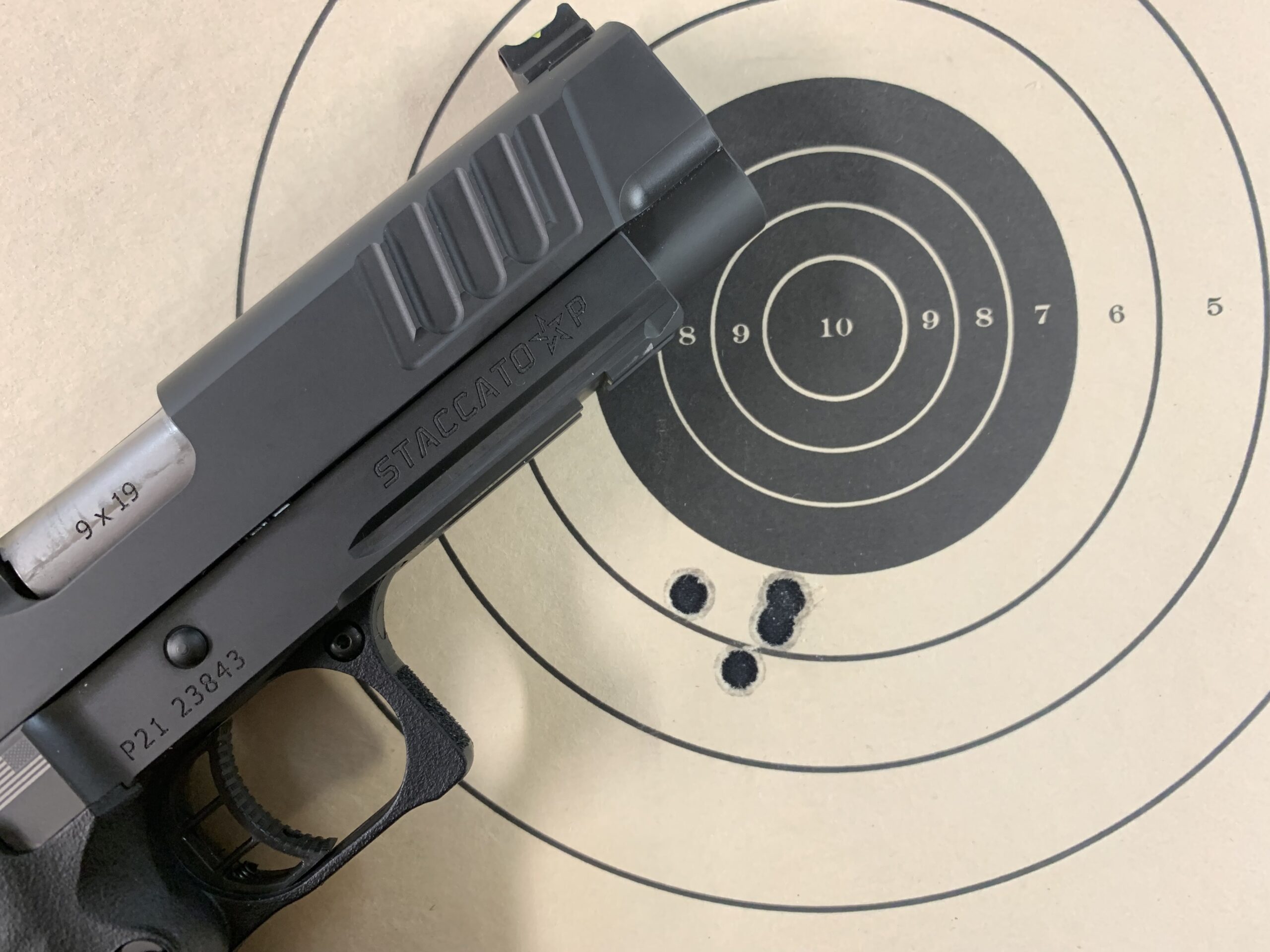Although 2011 pistols have been around for years, guns like the Staccato P have recently diffused into the mainstream shooting and duty market. Roughly 15 years ago, I observed that modernized double-stack 1911 pistols like the STI Edge were popular among Limited-class USPSA shooters when I was just dipping my toes in the game, but I hadn’t heard of them before entering that world. Shooters recognized that these fine-tuned 2011 pistols were easy to shoot and gave them a competitive advantage.
Staccato 2011, formerly known as STI, has built high-performance 2011 pistols for many years but outside competitive circles, they weren’t well-known. The company re-branded in 2020, taking on the name and the focus of its duty and defense “Staccato 2011” line. Previously, STI had offered close to two dozen models of 2011 and 1911 pistols, and now Staccato has sharpened their scope to variations of five models—all in 9mm. Those models revolve around the Staccato P, which is their full-size duty-grade pistol.
- Caliber: 9mm
- Capacity: 17+1 or 20+1
- Action: Single-action, hammer-fired
- Barrel: 4.4-inch, bull profile, stainless steel
- Dimensions: 8.1 inches (L) x 5.8 inches (H) x 1.3 inches (W)(grip)
- Weight: 37 ounces (w/empty 17-round magazine) (measured)
- Frame: 4140 billet steel (aluminum models available)
- Slide: 4140 billet steel
- Optics: Cut for optic, uses Dawson Precision optic system
- Controls: Right-handed slide stop, mag catch, ambidextrous safety levers
- Finish: Black DLC
- Grip: Polymer grip module, laser-etched stipple texture
- Sights: Dawson Precision fiber-optic front, serrated black square-notch rear (drift adjustable)
- Trigger: 1911-style single-action, curved shoe, 4 pounds, 2 ounces (measured)
- MSRP: $2,499
The Staccato P: 2011 Vs 1911
Although 2011- and 2011-style pistols have been growing in popularity, there are still many shooters who haven’t been acquainted. When talking about a 2011 pistol, it’s important to clarify what, exactly, a 2011 is.
The term 2011 has been used for a while, and trademarked, by STI/Staccato for their double-stack 1911-style pistols. Essentially, a 2011 pistol is a double-stack 1911 with a frame that terminates just below the top of the grip. Unlike single-stack 1911’s or older-style double-stack 1911’s, such as the Para Ordnance pistols, the Staccato P 2011 uses a separate polymer grip module rather than grip scales that attach to each side of a full-length frame.
A 2011 has generally the same controls, operation, and design as a single-stack 1911 pistol, but they’re all double-stack and most contemporary 2011s and 2011-style pistols are chambered in 9mm, rather than .45 ACP.
Nuts and Bolts of the Staccato P
Anyone familiar with the workings of a 1911 has a good start when it comes to the Staccato P. It’s a semi-automatic, single-action, hammer-fired pistol that’s fed from a double-stack magazine. The P has all the bullet-point features that you’d expect in a 1911: hammer, thumb safety, grip safety, a 1911-style (non-cantilever) trigger, and a slide-stop takedown pin.
When you start peeling back the layers, you’ll see some big divergences from your battered old M1911-A1. For starters, all the steel parts in the Staccato P are machined from billet or round-stock American steel—not forged, cast, or molded. The design and materials are modernized and optimized for both reliability and performance.

Slide, Barrel, and Recoil System
The slide on the Staccato P has a recognizable-but-refined 1911 look and a durable DLC finish. The slide has both front and rear cocking serrations that provide excellent traction for a sweaty hand to manipulate.
I got an optics-ready Staccato P that comes with a Dawson Precision fiber-optic front sight and a windage-adjustable rear sight/optic cover plate. The Staccato P doesn’t come with any specific optics plates, so you need to order the one you want. The pistol comes with a green fiber-optic installed in the front sight and a black serrated rear, but also includes alternative fiber optic colors like yellow, red, white, and black.
The Staccato P has a 4.4-inch heavy bull barrel with two locking lugs and a rotating barrel link. The extractor and firing pin are like what you’ll see in a normal 1911, but the recoil system is not. A standard 1911 will have a short guide rod that fits inside the recoil spring. The open end of the recoil spring fits into the spring plug at the front of the slide, just below the barrel. That’s the knurled “button” you’ll see under the muzzle on many 1911’s. That plug is normally held in place by a barrel bushing, but the Staccato P doesn’t have one.
The Staccato P has a full-length guide rod and a spring plug that cannot exit the front of the slide. Takedown is like a 1911, but to remove the spring, plug, and guide rod, the Staccato P has a handy spring-retaining feature. Older STI pistols required using a paper clip or other tools, and guide rods like those found on the Springfield Prodigy require an Allen key to take apart. On the P, simply press the guide rod from the rear to compress the spring until you can depress a lever that holds the plug and spring in a compressed position—then it comes right out of the slide.

Frame and Grip Module
As mentioned, the frame of the Staccato P is like the upper part of a 1911 frame but terminates just below the top of the grip. The frame houses the thumb safety, disconnector, hammer components, and features a single-slot accessory rail forward of the trigger guard. It sports robust slide rails, and the ejector and disconnector will look familiar to any 1911 shooter.
The polymer grip module houses the mainspring and sear spring and has an aggressive laser-etched stipple texture. The grip safety is raised at the bottom for easy activation, and it has a beavertail to protect the shooter from hammer bite. The magazine catch button is non-ambidextrous, and not over-sized, but it’s extended slightly for easy activation. The curved trigger shoe is polymer and the trigger’s surfaced has a slightly raised checker-texture for a precise feel and control. The grip module is capped with a medium-sized aluminum magwell that aids with speedy reloading and has side cuts for peeling out a stuck magazine.
Magazines
The Staccato P comes with three magazines: two 17-round and one 20-round. The magazines have steel bodies and easily removable aluminum baseplates—the same magazines are compatible with other full-size Staccato Pistols like the XL and XC. They’re also cross-compatible with many other 2011-style pistols. Because the frame and slide are only as wide as traditional single-stack 1911’s, the magazines are bottlenecked from double- to single-stack at the top. Extra Staccato magazines are expensive, but they’re high-quality, serviceable products.
During testing, I found Springfield Prodigy magazines to function perfectly in the Staccato P, and I noted that both Staccato and the Springfield magazines were easy to seat under a closed slide when fully loaded. Some pistols require significant force to seat loaded magazines, and having a magazine fail to seat properly can cost precious seconds. That’s not an issue with this pistol.
Fit, Finish and Function
The Staccato P is a premium pistol that’s priced accordingly. Because of that you can, and should, expect a high standard for fit and finish. The P isn’t flashy, but its DLC finish is uniform and durable. After testing, I can pick out only the slightest finish wear on the accessory rail from my Streamlight TLR-1, and a little bit of finish wear inside the rail channels on the slide; that’s it.
When the pistol was new, I immediately noted the ultra-tight, glassy fit between the slide and frame. It’s built so tight in fact, that you need to lubricate it properly—especially during the break-in period. After firing approximately 1,350 rounds through my Staccato P, I still can’t detect any slop or play between the slide and frame. I’ve shot more than a few 1911’s that rattle like a panhandler’s collection can after a couple hundred rounds—that’s not an issue with the P.

A Secure Grip
The grip on the Staccato P is robust, which can be a double-edged sword. Lots of grip real estate allows your hands more contact with the gun, which can mean a more secure grip, but it can make controls difficult to reach for shooters with smaller hands. For my hands, it doesn’t get much better. The grip fits well, is easy to index repeatable and consistent hand placement, and it’s not going to slip with that stipple texturing.
Controls on the P are fit well and smooth operating. The thumb safety is ambidextrous, and it flips on and off with a soft, but tactile and audible click. There’s no slop or sponginess in the safety levers at any point. The safety levers on many pistols are easy to disengage, but stiff and difficult to re-engage; the Staccato P’s safety is just right.
The only control that could be a challenge to reach with the is the slide stop lever. I can reach it without breaking grip, but some shooters will likely want to use their support hand thumb to cut the slide loose after loading a fresh magazine. I noted that the bottom surface of the slide stop lever is scalloped out to provide a nice edge that gives purchase while manually locking the slide open. That’s a nice touch.
A Crisp Trigger
Although heavier than those of some of Staccato’s competition models, the trigger on the P is great. It’s weight of 4 pounds, 2 ounces is by design; the heavier trigger weight allows it to qualify for law enforcement use and reduce the chance of a negligent discharge. The trigger has a small bit of movement before hitting rigid resistance, then it breaks clean. The reset is short, crisp, and has good spring pressure to drive the trigger forward.
Hitting the Range with the Staccato P
The biggest claim that Staccato makes about the Staccato P is that it’s not just accurate, but easy to shoot accurately. Those are two very different things. Shooting any handgun well is a perishable skill, and if you shoot a variety of handguns, you’ll quickly find that some are simply easier to shoot well than others. A pistol can feel great at the gun store counter, but you really need to shoot it before passing judgement. For me to justify the price of as pistol like the Staccato P, I’d damn well better be able to feel a tangible difference.

The Staccato P is a Smooth Shooter
I won’t sandbag things; the Staccato P is one of the most shooter-friendly pistols that these tender hands have held. It’s spoiled me when it comes to duty-grade shooting irons. The excellent ergonomics and grip angle make it point fast and easy, and the recoil cycle is smoother than soft-serve ice cream. With a good grip, the sight or dot falls right back to where it was when the trigger broke. That makes it an incredibly fast and fun pistol to shoot. When shooting it alongside mainstay duty pistols like the Glock G19, the new G47 MOS, and the Sig P320, the Staccato P is plainly easier to shoot fast and accurately.
As a matter of practical accuracy, the Staccato P is a winner. Keeping hits in the A zone on an IPSC/USPSA target at 50 feet while pausing only to catch the reset is easier than any of the old STIs I remember shooting. At the common drill range of 7 yards or 21 feet, slapping quick doubles usually yielded center A-zone impacts only an inch or two apart. One-to-fives and Bill drills got me yelled at in the local indoor range, but the impacts seldom left the A-zone.
To ensure I wasn’t simply starstruck, I had a green beret buddy—who on one deployment made it a personal mission to through an entire connex full of 9mm ammo with his Glock G19—try the Staccato P. After a couple weeks of reflection, he couldn’t get it out of his head and told me that it’s got to be the nicest-shooting pistol he’s ever fired.
Shooting Groups
Practical accuracy and how easy a pistol is to manage are of primary importance, but for an expensive bull-barrel 1911, I wanted to see what kind of accuracy I could get too. I fired 10 5-shot groups with Federal Premium 124-grain HST from 50 feet at a B2 50-foot NRA bullseye target. I fired from a supported position using iron sights, and the groups averaged 1.15 inches. Taking the bullet diameter into account, that’s small enough to keep them all cutting the 10-ring.

Reliability and Longevity
A critical factor for any duty-grade pistol, especially an expensive one, is reliability. It’s one that Staccato stresses for their pistols—especially the P. A point of pride for Staccato is that the P is approved for duty use by over 900 law enforcement agencies and is currently in service with several high-profile agencies including the Austin, Dallas, Miami Dade, Long Beach, and LAPD SWAT teams.
Read Next: Best 9mm Pistols
If I’d had a complaint or observation about the older STI pistols I’d shot or that friends shot in competition, it’s that they could be finicky. Requiring fine tuning is one thing for a competition gun, but it’s not an option for a duty or carry gun. With their sharper focus on these models, Staccato seems to have homed in on high-performance shootable guns that are also very reliable—and that proves to be the case with the gun I’ve been shooting. It’s functioned flawlessly.
The only caveat I can see that concerns the reliability of the Staccato P is that there’s no free lunch, and the tight fit and improved performance will require a higher level of maintenance and lubrication than your average striker-fired pistol.
For some additional input on the longevity of the platform, I asked OL contributor and USPSA Grand Master shooter Sean Murphy about his experience with the Staccato P. “They only get better once you get a few thousand rounds on them,” he told me. Murphy said one of his Staccato P pistols has 20,000 rounds through it and is still going strong.
What the Staccato P Does Well
The Staccato P is an excellent combination of quality parts, good fit, and ultimate shootability. If I could only own one full-size 9mm, this would be it.
Where the Staccato P Could Be Better
The only downsides I can come up with on the Staccato P is that some shooters will have to use their support hand to manipulate the slide stop lever, and that generally, the 2011 will be a higher-maintenance gun than something like a Glock. It’s more refined and less of a blunt object, but it needs to be well-lubricated.
